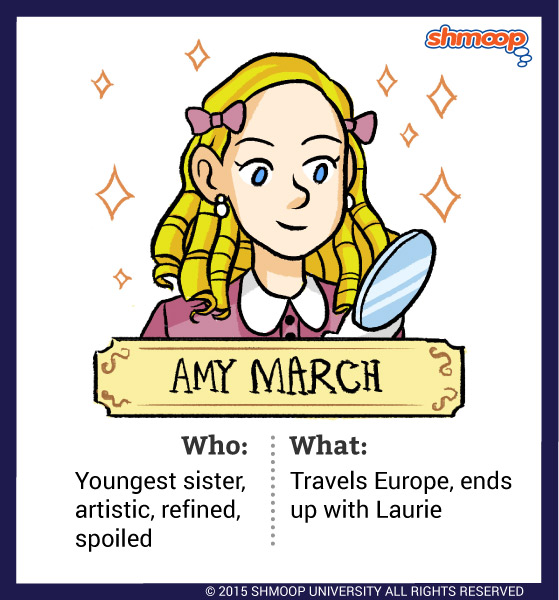Character Analysis

(Click the character infographic to download.)
Amy is the March sister that most readers love to hate. She's the youngest of the family and she fits the stereotype of the spoiled youngest child. Amy's vanity begins with her appearance – she's a pretty child and turns into a beautiful, stately woman, with lovely golden hair and blue eyes. The only thing that bothers her is that her nose isn't quite aristocratic-looking enough – it's a little snub nose, instead of a stately Roman nose. You can bet that if Amy had lived in an era of plastic surgery, she'd have gone in for a nose job. As it is, she has to try to reshape her nose herself by wearing a clothespin on it while she's sleeping. (Shmoop does not recommend this home-nose-job technique.)
Amy's anxiety about her nose, however, is just the beginning of her obsession with all things upper-class. Amy's great ambition is to be a gentlewoman. She tries to make the most of her clothes and accessories, cultivates grace and politeness, and makes social calls on the family's wealthy friends and neighbors. She's pretty successful at it, too. Amy's interest in high society might be shallow, but her kind heart is deep, and people appreciate her classy behavior.
As a child, her ambitions seem ridiculous – she's always misusing big words and affecting little snobby behaviors. Sometimes she even shows signs of a violent temper, such as when she burns one of Jo's manuscripts in revenge for being left at home while her sisters and Laurie attend a play. And she's also overly sensitive, possibly even spoiled – one punishment for breaking the rules at school is enough to make her resolve never to go back. But when she grows into a woman, Amy is far more genteel, and she's a big hit, both at home and abroad.
In fact, it's Amy's decorous behavior that convinces her Aunt Carrol to take her to Europe and her Aunt March to pay for the trip. Amy hopes to use her European adventure to cultivate and refine her artistic skills. From childhood on, Amy's tried every kind of visual art there is, from painting to sketching to sculpting. Most nineteenth-century young women dabbled in these arts, but Amy hopes to make a career out of them. In fact, she wants more than a career; she wants to do the work of genius. Eventually, Amy has to admit to herself that, while she's talented, she doesn't have that special extra inspiration that would mark her as a true artist. Instead, she contents herself with fashioning her life artistically.
It's easy for Amy to turn her focus from her art to her life when Laurie arrives in Europe and starts hanging out with her. Freed from the patterns of interaction that were set for them by the family dynamic back home, Amy and Laurie discover each other anew. Laurie realizes that Amy is exactly the kind of graceful, principled woman who would make a good wife for him, and Amy realizes that Laurie's strength and comfort mean more to her than anyone else's ever could. Sadly, this disrupts Amy's plan to be a gold-digger and marry the wealthy Fred Vaughn for his money. But, as Marmee's daughter, Amy was always destined to realize that love means more than money, and that respect is an important component of marriage. Of course, she still gets the money anyway, since Laurie himself is rich...but who's keeping track?